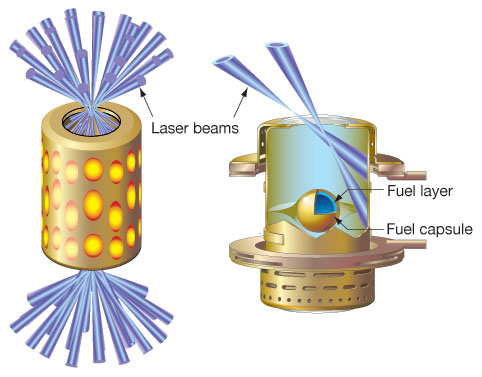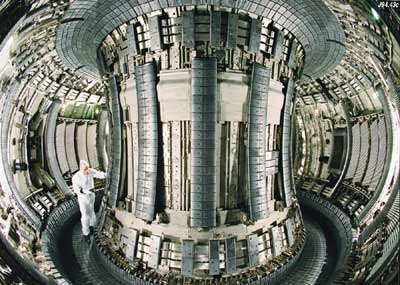Inertial Confinement
Another confinement method that is being researched is called Inertial Confinement in which a deuterium-tritium pellet encased in a plastic cylinder is dropped into a chamber where many high power laser beams (192 beams in the one at the Lawrence Livermore Laboratory) are focused on the pellet while it is falling, all of which hit the cylinder at exactly the same moment. This intense energy heats the cylinder creating X-Rays, this turns the fuel into a plasma and compresses it inwards much like an implosion. This reaction takes all of a millionth of a second and requires 1.8 million Joules from the lasers, but within that fraction of a second gives off anywhere between 50-100 times the amount of energy needed to start the process. Identical to how the heat energy would be transferred by the Tokamak in that it would require a moderator like water to transfer the heat gained to steam, and this pressure would turn a turbine to create electrical power. This type of confinement is not yet refined, and will likely require at least the amount of time that ITER will to finally breakeven with the actual amount of power they can get from this reaction. Below is an image of a inertial confinement cylinder with fuel inside: 
Courtesy of: https://lasers.llnl.gov/programs/images/target_capsule_ill.jpg
|
Magnetic Confinement
The idea for the magnetic confinement is that microwaves, electricity, and particle beams heat the reactant gas turning it into a plasma, which are contained by a very powerful set of magnets that keep the hot plasma from touching the walls. This will allow for a controlled fusion reaction to take place inside the confined area. The most efficient design for this type of generator is in the shape of a donut, a shape known as a toroid. This donut shaped fusion reactor is known as a Tokamak which is an abbreviation consisting of several Russian words meaning "toroidal chamber with magnetic coils" in English. A quick note for those who are worried that a nuclear disaster like Chernobyl could occur from this fusion reactor will be pleasantly surprised; if you were to take an axe and cut open the Tokamak, rather than a nuclear explosion rushing out, air would rush into the chamber and kill the reaction entirely. This is due to the fact that the pressure inside the reactor is much less than the surrounding air. There are several projects underway right now to create this exact type of fusion reactor, however none of these fusion reactors have ever reached breakeven, which is the point in which the amount of energy going towards starting the reaction is exactly the amount of energy coming out of the reaction. This may not be the case for too much longer though, as a particular tokamak called ITER (International Thermonuclear Experimental Reactor) is close to changing that fact. This is believed to be the first ever fusion reactor that will be able to breakeven and the goal from there would be to have a reactor that was capable of igniting or giving off more energy than was required to start the reaction. Some leading scientists believe that we could see this international project go live between 2016-2018, meaning that we should all see fusion energy become a viable form of power in our own lifetime. Here is an image of the inside of a Tokamak:  Courtesy of: http://www.emi.ac.ma/eminence08/images/stories/photos%2016%20edit/tokamak.jpg
Courtesy of: http://www.emi.ac.ma/eminence08/images/stories/photos%2016%20edit/tokamak.jpg
|

 Courtesy of: http://www.emi.ac.ma/eminence08/images/stories/photos%2016%20edit/tokamak.jpg
Courtesy of: http://www.emi.ac.ma/eminence08/images/stories/photos%2016%20edit/tokamak.jpg